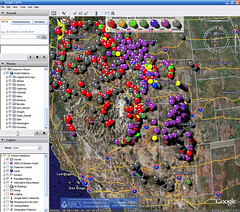In his ongoing drought series, Daniel Collins had a nice post last week on a trio of studies about the relationship between climate variability and both recruitment and death of piñon, the scraggly little arid pine tree provides our landscape’s signature here (when drought or global warming isn’t killing it).
I’d like to extend the discussion with reference to a paper that came out in 2000 in ecology that sheds some interesting light on what happens at the tree-by-tree scale rather than the landscape scale discusssed in the papers Daniel cited. It’s Tree-ring variation in pinyon predicts likelihood of death following severe drought. The research team, led by Kiona Ogle (at Northern Arizona at the time, now at Wyoming) compared tree rings in trees that survived a 1996 drought and those that died.
One of the characteristics of the arid climate in which piñon live is variability – significant differences between the wet years and the dry years. You can think of it, in statistical terms, as having a large standard deviation relative to the mean. Wet places, say a place like southeast Louisiana, which gets 60 inches (150 cm) a year of rain, have relatively low variability. The driest year on record in the U.S. climate division data for southeast Louisiana saw 66 percent of the yearly average precipitation. Yuma, the canonical dry as dust U.S. city, has huge variability. The driest year in the U.S. climate division data for southwest Arizona (Yuma) was just 17 percent of average. So things living in arid climate have to not only be adapted to less water in general, but also to really dry extremes. Piñon country is arid, having generally high variability.
Life at all scales – organizations, communities, individuals, societies – need the flexibility to handle that variability. Ogle found a clear difference between the trees that lived and those that died. The dead trees tended to have much greater variability in their growth rings, putting on much fatter rings in wet years relative to their dry year rings. I think there’s an important message here, by way of metaphor, for human societies. If you look at societies that have flourished and those that have failed, a distinguishing characteristic is the way they responded to the wet side of the natural range of variability.



